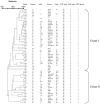Multilocus sequence typing for analyses of clonality of Candida albicans strains in Taiwan
- PMID: 16757617
- PMCID: PMC1489451
- DOI: 10.1128/JCM.00320-06
Multilocus sequence typing for analyses of clonality of Candida albicans strains in Taiwan
Abstract
Multilocus sequence typing (MLST) was used to characterize the genetic profiles of 51 Candida albicans isolates collected from 12 hospitals in Taiwan. Among the 51 isolates, 16 were epidemiologically unrelated, 28 were isolates from 11 critically ill, human immunodeficiency virus (HIV)-negative patients, and 7 were long-term serial isolates from 3 HIV-positive patients. Internal regions of seven housekeeping genes were sequenced. A total of 83 polymorphic nucleotide sites were identified. Ten to 20 different genotypes were observed at the different loci, resulting, when combined, in 45 unique genotype combinations or diploid sequence types (DSTs). Thirty (36.1%) of the 83 individual changes were synonymous and 53 (63.9%) were nonsynonymous. Due to the diploid nature of C. albicans, MLST was more discriminatory than the pulsed-field gel electrophoresis-BssHII-restricted fragment method in discriminating epidemiologically related strains. MLST is able to trace the microevolution over time of C. albicans isolates in the same patient. All but one of the DSTs of our Taiwanese strain collections were novel to the internet C. albicans DST database (http://test1.mlst.net/). The DSTs of C. albicans in Taiwan were analyzed together with those of the reference strains and of the strains from the United Kingdom and United States by unweighted-pair group method using average linkages and minimum spanning tree. Our result showed that the DNA type of each isolate was patient specific and associated with ABC type and decade of isolation but not associated with mating type, anatomical source of isolation, hospital origin, or fluconazole resistance patterns.
Figures


Similar articles
-
Usefulness of multilocus sequence typing for characterization of clinical isolates of Candida albicans.J Clin Microbiol. 2002 Apr;40(4):1290-7. doi: 10.1128/JCM.40.4.1290-1297.2002. J Clin Microbiol. 2002. PMID: 11923347 Free PMC article.
-
Multilocus sequence typing for the analysis of clonality among Candida albicans strains from a neonatal intensive care unit.Med Mycol. 2014 Aug;52(6):653-8. doi: 10.1093/mmy/myu028. Med Mycol. 2014. PMID: 25037934
-
Genetic diversity among Korean Candida albicans bloodstream isolates: assessment by multilocus sequence typing and restriction endonuclease analysis of genomic DNA by use of BssHII.J Clin Microbiol. 2011 Jul;49(7):2572-7. doi: 10.1128/JCM.02153-10. Epub 2011 May 11. J Clin Microbiol. 2011. PMID: 21562112 Free PMC article.
-
Multilocus sequence typing of Candida albicans: strategies, data exchange and applications.Infect Genet Evol. 2004 Sep;4(3):243-52. doi: 10.1016/j.meegid.2004.06.002. Infect Genet Evol. 2004. PMID: 15450203 Review.
-
Multilocus sequence typing of pathogenic Candida species.Eukaryot Cell. 2008 Jul;7(7):1075-84. doi: 10.1128/EC.00062-08. Epub 2008 May 2. Eukaryot Cell. 2008. PMID: 18456859 Free PMC article. Review. No abstract available.
Cited by
-
Multilocus sequence typing of the porcine and human gastric pathogen Helicobacter suis.J Clin Microbiol. 2013 Mar;51(3):920-6. doi: 10.1128/JCM.02399-12. Epub 2013 Jan 9. J Clin Microbiol. 2013. PMID: 23303499 Free PMC article.
-
Candida albicans strain maintenance, replacement, and microvariation demonstrated by multilocus sequence typing.J Clin Microbiol. 2006 Oct;44(10):3647-58. doi: 10.1128/JCM.00934-06. J Clin Microbiol. 2006. PMID: 17021093 Free PMC article.
-
Cariogenicity of Candida albicans of distinct genotypes among 3-5-year-old Uygur children in Kashgar, China- a case-control study.BMC Oral Health. 2018 Dec 5;18(1):203. doi: 10.1186/s12903-018-0658-4. BMC Oral Health. 2018. PMID: 30518349 Free PMC article.
-
Molecular phylogenetics of Candida albicans.Eukaryot Cell. 2007 Jun;6(6):1041-52. doi: 10.1128/EC.00041-07. Epub 2007 Apr 6. Eukaryot Cell. 2007. PMID: 17416899 Free PMC article.
-
Genetic diversity among Candida albicans isolates associated with vertical transmission in preterm triplets.Mycopathologia. 2014 Oct;178(3-4):285-90. doi: 10.1007/s11046-014-9803-z. Epub 2014 Aug 24. Mycopathologia. 2014. PMID: 25151365
References
-
- Ball, L. M., M. A. Bes, B. Theelen, T. Boekhout, R. M. Egeler, and E. J. Kuijper. 2004. Significance of amplified fragment length polymorphism in identification and epidemiological examination of Candida species colonization in children undergoing allogeneic stem cell transplantation. J. Clin. Microbiol. 42:1673-1679. - PMC - PubMed
-
- Chen, K. W., H. J. Lo, Y. H. Lin, and S. Y. Li. 2005. Comparison of four molecular typing methods to assess genetic relatedness of Candida albicans clinical isolates in Taiwan. J. Med. Microbiol. 54:249-258. - PubMed
-
- Chen, Y. C., S. C. Chang, K. T. Luh, and W. C. Hsieh. 2003. Stable susceptibility of Candida blood isolates to fluconazole despite increasing use during the past 10 years. J. Antimicrob. Chemother. 52:71-77. - PubMed
Publication types
MeSH terms
Substances
Grants and funding
LinkOut - more resources
Full Text Sources
Medical

